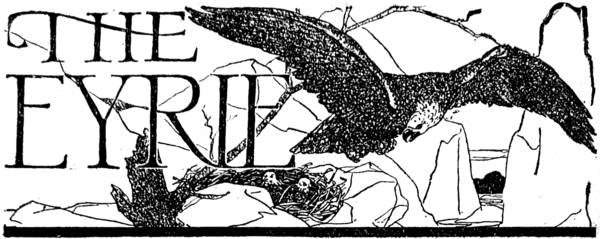
The enthusiastic reception of Seabury Quinn's story, Roads, in our January issue, has encouraged us to print further off-the-trail stories from time to time in this magazine. This story was a reverent tale of the Crucifixion, a hetaera from the house of Mary of Magdala, and Santa Claus. Though there were a few dissident voices of those who thought the Santa Claus element childish, the chorus of praise made the vote overwhelming in its favor.
Suited to a T
William F. Zuckert, Jr., of Washington, D. C, writes: "After ten years as a silent reader of WT, I take this opportunity to drop a line to the Eyrie. As a whole, I can find little or no criticism against our magazine, because personally it suits me to a T. Besides, on the very rare occasions when I do have an infinitesimal gripe, I say nothing because I realize that there must have been plenty of readers who did enjoy the piece; who am I to yelp? I like the high literary quality of the tales, with that subtle horror that sort of sneaks up on one. Now for a couple of orchids to the authors. In the December issue, I particularly enjoyed The Sea-Witch by Nictzin Dyalhis. In my humble estimation, this yarn constitutes one of the smoothest bits that I've ever read. It didn't hold a dull moment nor an arid paragraph from beginning to end. This letter would be incomplete without a mention of my favorite author and character. I refer, of course, to Seabury Quinn with his inimitable Jules de Grandin—a grand pair whose adventures I hope to be able to follow as long as these old eyes can see the printed page. Flames of Vengeance in the December issue was grand, but when the January issue came out with Roads, I got a real sock! What a story! I was almost on the last page before it dawned on me just who Claudius really was! That idea was a real inspiration, and you gave it to us at exactly the proper time of year. Keep up the good work, Mr. Quinn, and I can personally guarantee you at least one family of very avid readers. I could go on for pages extolling the virtues of the various authors, but that isn't very practical, because perhaps you would like to squeeze in a letter from some other reader. So I close now with a big cheer for Virgil Finlay. And thanks for listening."
The Light Was Green
Richard F. Behm writes from Los Angeles: "Thank you for John Speer's story, The Light Was Green. A long time has passed since I have read any fiction as unusual and fascinating as the stories written by Mr. Speer. It is very evident he does not write until he is definitely sure of the ground from which his inspiration for his story sprung."
A Letter from Miss Hemken
Gertrude Hemken writes from Chicago: "Roads! This is by far the loveliest Christmas story I have ever read. Quinn couples the Teutonic legends of the Nativity so beautifully. But one thing wonders me—Klaus, after a tricennium, still had the fair hair and beard; yet the Santa Claus we know is a white-haired, white-bearded old fellow. 'Course after two thousand years most anyone would grow gray, but—never mind. Somehow or other I was a mite disappointed in Dorothy Quick this time. Her witch was somehow so very like another enchantress in a w.-k, story by an equally w.-k. author. I really don't care for these supple sirens and their frightening powers. Give me a couple of rip-snorters like Conan and North-west Smith—brave lassies like Jirel of Joiry. 378
